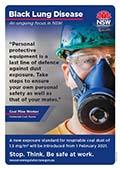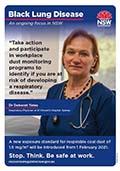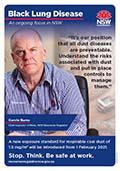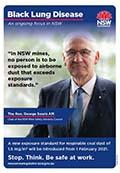Dust diseases
Dust diseases caused by exposure to airborne contaminants can kill or cause serious long-term health complications for workers.
Pneumoconiosis and silicosis are just two preventable dust diseases that require appropriate dust controls, atmospheric monitoring and worker health monitoring.
NSW has a comprehensive regulatory scheme in place under the Resources Regulator and Coal Services, with specific mining health and safety legislation.
The NSW Mine Safety Advisory Council leads a long-standing tripartite approach to health and safety issues across all sectors in the mining industry.
Standards for respirable dust
The NSW work health and safety framework consists of the most rigorous coal dust exposure limits in Australia, including legislated requirements for minimum standards of ventilation, monitoring of airborne contaminants in the workplace, and prescribed worker health monitoring regimes for exposure to airborne dust.
The NSW Government has supported more stringent exposure standards for respirable dust, agreeing to Safe Work Australia’s recommendation to reduce respirable coal dust from 2.5 to 1.5 mg/m3 and respirable crystalline silica from 0.1 to 0.05mg/m3. NSW also supports additional research on whether further reductions are achievable.
Coal dust
Coal mine workers receive a medical assessment before beginning employment, health surveillance every three years, and are offered free ongoing medical assessments after they leave the industry.
NSW’s coal sector also has The Standing Committee on Airborne Contaminants and Occupational Hygiene (known as the Standing Dust Committee).
Respirable silica
The new respirable crystalline silica workplace exposure standard of 0.05mg/m3 took effect in NSW from 1 July 2020.
Reporting requirements
Mines must report respirable coal dust exceeding 1.5 mg/m3 of air breathed and respirable crystalline silica dust exceeding 0.05 mg/m3 of air breathed to the Resources Regulator. All exceedance reports are reviewed by the Resources Regulator, and where appropriate, investigations undertaken to ensure remedial actions have been implemented.
Mine operators also have a duty to notify the Resources Regulator, in accordance with clause 376 of the NSW Work Health and safety Regulation 2017, in the event that a worker receives a health monitoring report which indicates the worker may have contracted a disease due to exposure to respirable crystalline silica, or where report recommends remedial measures, including whether a worker can continue to carry out work in an environment where they may be exposed to respirable crystalline silica.
Targeted mine assessments for dust exposure
During 2018-19, 68 targeted mine assessments and inspections were carried out as part of a major compliance campaign to ensure appropriate dust control measures are in place to minimise exposure risks to workers. This program commenced in 2016 and is ongoing.
Inspection and mandatory testing show most NSW underground coal mines have maintained exposure levels to well below the prescribed limits.
Guidance has also been developed to assist mine operators to implement health control plans and manage and control risks associated with dust and airborne contaminants.
Any worker, current or retired, who has concerns about their respiratory health should contact their nearest Coal Services office or consult their doctor.
NSW has the most stringent dust exposure standards in Australia. A new exposure standard for respirable coal dust to 1.5mg/m3 will be introduced from 1 February 2021. Further reduction of the exposure standard will ensure NSW continues to have the strongest regime for protecting workers’ health and safety.
Dust disease toolkit
The Take Action to Prevent Dust Disease toolkit is designed to provide mine workers and mine operators with information, advice and guidance related to managing dust. The member organisations of the Mine Safety Advisory Council have combined resources to create this dust toolkit, which is designed to provide mine workers and mine operators with information, advice and guidance related to managing dust.
Black lung disease: an ongoing focus in NSW
Supporting this change, this campaign is designed to educate workers and mine operators of the risks associated with respirable coal dust.

|

|

|

|
Completed investigations of dust disease
There have been a number of recent identified cases of coal worker pneumoconiosis and simple silicosis in the NSW mining industry which has kept this issue an ongoing focus for the Resources Regulator. The table below lists all completed investigations of dust disease specified in schedule 1 of the Workers’ Compensation (Dust Diseases) Act 1942 received by the Resources Regulator.
Table of completed investigations of dust disease
Regulator notified: 17 August 2023
Dust disease: Sarcoidosis
Worker: A 51-year-old male metalliferous mine worker has been diagnosed with sarcoidosis in the context of simple silicosis.
Status: The worker's injury has been attributed to exposure to mining related dust by health professionals. The worker has worked for 11 years at one mining operation as a surface plant mechanic. The worker has only worked at one mining operation. The worker's other workplaces have been in relatively sterile environments (food processing and pharmecuticals) that would not be considered to contain the hazard of respirable silica.
Regulator notified: 20 February 2023
Dust disease: Coal workers pneumoconiosis (CWP)
Worker: A 61-year-old male underground coal mine worker has been diagnosed with coal workers' pneumoconiosis (CWP).
Status: The worker has a small amount of scarring that can be attributed to smoking. The worker's condition has been diagnosed as minor and has been cleared to continue working in an underground environment. The worker originates from the United Kingdom and spent the majority of his working life working in the UK coalfields. The worker has a total of 34 years working in an underground environment.
Regulator notified: 13 October 2022
Dust disease: Chronic obstructive pulmonary disease (COPD)
Worker: A 62-year-old contract high pressure water cleaner has been diagnosed with chronic obstructive pulmonary disease.
Status: The worker has a history of significant tobacco consumption, which is a major cause of COPD and chronic bronchitis. However, significant coal mine dust, silica dust and contaminated water exposure are known to be contributory factors to COPD. Coal Services Pty Ltd do not hold any occupational exposure results for the worker's SEG (similar exposure group) that would demonstrate that he was exposed to dust above the occupational exposure limit. There is no evidence that has been identified that demonstrates the worker has been exposed to coal or silica dust above the occupational exposure limit.
Anecdotally, the environment in and around ROM bins and primary crushers was a very dusty environment. Significant dust mitigation strategies have been developed in the last couple of years to combat dust generation around these areas.
Regulator notified: 21 June 2022
Dust disease: Silicosis
Worker: A 57-year-old male has been diagnosed with silicosis following health monitoring organised by ICARE. The worker is fit to continue work at the mine provided that they are not exposed to further respirable dust.
Status: The worker was unable to be located and has actively avoided significant enquiries made by the Regulator. The preliminary investigation identified:
1. The worker has worked in the NSW sandstone quarrying and masonary industry since 2016 with no pre employment health check undertaken
2. The worker does not speak English and it is unknown where he has worked previously
3. Anecdotally the company said he had extensive experience dry cutting stone overseas and was a heavy smoker.
Regulator notified: 17 June 2022
Dust disease: Silicosis
Worker: A 39-year-old male has been diagnosed with significant silicosis from occupational dust exposure (ILO 0/1). Diagnosis interpreted on High Resolution CT (HRCT) chest scan.
Status: The worker was employed in various roles at a large underground metal mine in central NSW since 2009. The worker's role has included general underground construction duties including concrete cutting, grouting, and working on foot in active mining zones, including around the primary crusher. The worker also has extensive experience working as a cabinet maker and farm hand. The prognosis for the worker is well provided he refrain from working in high dust environments.
There is a evidence that a chronic exposure may have arisen from 13 years working at a single mine where the worker previously worked. The worker has had multiple employers while working at the mine. There is little evidence to suggest that any employer has breached its work health and safety duties. This mine is no longer operational. The worker's employer has recently changed the worker's role to supervisory. it is expected that this will reduce his exposure to respirable dust.
Regulator notified: 11 March 2022
Dust disease: COPD
Worker: A 49-year-old male is under specialist investigation with a differential diagnosis of respiratory bronchiolitis interstitial lung disease from smoking or coal workers pneumoconiosis. The diagnosis remains unconfirmed.
Status: The treating specialist has advised the worker that he must quit smoking before he can undertake further invasive (lung biopsy) procedures to refine his diagnosis and specialise his treatment. The worker was able to reduce his cigarette consumption but not quit completely. The worker’s symptoms have decreased dramatically since the reduction in tobacco consumption. A biopsy has not been completed.
The workers history as a scaffolder and rigger in the mining industry does not lend itself to a high risk of exposure to respirable coal dust and based on the available evidence it is not possible to allege that a NSW mining operation contributed significantly to the worker's injury. There is no evidence obtained that suggests a NSW mining operation has breached its WHS duties. The worker does not wish to pursue the matter any further and no longer works in the mining industry.
Regulator notified: 28 January 2022
Dust disease: Silicosis
Worker: A 50-year-old worker has received a diagnosis of early lung disease, most likely silicosis. The diagnosis is interpreted on High Resolution CT (HRCT) chest scan.
Status: The worker is asymptomatic but has CT scan evidence of mild silicosis (ILO score 1/2). Lung function is normal, he is fit to work but must follow harm minimisation measures. The worker should (and does) wear at least a P2 dust mask. The worker continues to see a specialist respiratory and sleep physician. Based on the available evidence it is not possible to allege that a NSW mining operation contributed significantly to the worker's exposure to respirable silica. There is a low probability that a chronic exposure may have arisen from 20 years working at a local open cut mine and quarry where the worker previously worked for approximately 7 years. There is no evidence obtained that suggests either operation has breached its WHS duties.
Regulator notified: 12 August 2021
Dust disease: Simple Coal Workers Pneumoconiosis and respiratory bronchiolitis interstitial lung disease
Worker: A 52-year-old underground coal mine worker has been diagnosed with simple coal workers pneumoconiosis and respiratory bronchiolitis interstitial lung disease. The worker has been an underground coal mine worker for approximately 20 years and worked as a tunneller in Sydney for one year. Prior to this, the worker worked as a carpenter.
Status: The worker has been advised that they should avoid ongoing exposure to coal dust and silica dust and that he refrain from smoking cigarettes. The worker has been advised that if he avoids coal dust and silica dust his long-term health prognosis is excellent with near-normal lung function. The treating doctor has advised the worker that the chances of developing complicated coal workers' pneumoconiosis are very low. Investigations are continuing.
Regulator notified: 6 May 2021
Dust disease: Probable Simple Silicosis - Coal Workers Pneumoconiosis
Worker: Male, late 40s Still employed as an Open Cut - Coal Surveyor. The worker has undertaken work in the NSW coal industry as a surveyor since 2008. The worker conducted work surveying coal stockpiles manually on foot (a practice no longer undertaken).
Status: The investigation identified that there is a low probability of sarcoidosis or other interstitial lung diseases. The worker has no symptoms and normal lung function. The worker's condition is not expected to worsen provided they work in a low dust environment.
It is not possible to determine the exposure location due to the numerous work locations the worker frequented. It is suspected the exposure was a result of working in and around coal stockpiles on foot. Matter closed.
Regulator notified: 6 May 2021
Dust disease: Category 1 - Coal Workers Pneumoconiosis
Worker: Male, early 60s, coal miner, boilermaker, machine operator. The worker has worked in the underground coal and steel making industry for about 33 years.
Status: The investigation identified that the worker is at retirement age and has been instructed to refrain from working in dusty environments. The worker is currently asymptomatic.
The Regulator formed the view that the worker was exposed to airborne dusts at several mines and coking operations during his career, as such it would be unable to determine the origin, cause and circumstances of the illness. Matter closed.
Regulator notified: 22 February 2021
Dust disease: Presumptive - Chronic Simple Silicosis
Worker: Male, 60s. Various roles across metal and coal operations, including operator and supervisory roles. The worker has had a long and varied career across gold, lead, zinc, copper, iron ore, and coal operations. The worker has worked in multiple jurisdictions above and below ground including overseas.
Status: The worker has been advised that he can return to work but to stay out of dusty environments. The investigation identified that the worker's injuries are cumulative.
The Regulator formed the view that the worker was exposed to airborne dusts at several operations during his career, as such it would be unable to determine the origin, cause and circumstances of the illness. Matter closed.
Regulator notified: 24 November 2020
Dust disease: Silicosis
Worker: Male Late 40’s.
Worked predominantly in tunnelling (Sydney and Brisbane region) and mining as an operator and supervisor. The worker has spent most of his career as a machine operator in the tunnelling industry. This work has involved tunnelling through Sydney and Brisbane sandstone. Silica is a major component of these sandstone structures.
Status: The worker is asymptomatic but has CT evidence of mild silicosis (ILO score 1/1). Lung Function is normal, he is fit to work but must follow harm minimization measures. The worker should wear at least a P2 cartridge respirator. The worker spent a considerable amount of their career tunnelling Sydney and Brisbane sandstone.
Based on the available evidence it would be fair to assume that there is a high likelihood that his exposure has arisen from his time in this industry. This is outside the jurisdiction of the NSW Resources Regulator. Matter closed
Regulator notified: 14 May 2020
Dust disease: Simple silicosis
Worker: Male, late 30s. Worked in underground tunnelling in NSW and Queensland, mines in Western Australia, and currently working in coal mines in NSW.
Status: Following an investigation, the Regulator formed the view that the worker's condition was not caused by exposure to silica containing airborne dusts at coal mining workplaces in NSW. Matter closed.
Investigation report (PDF, 668.88 KB)
Regulator notified: 7 May 2020
Dust disease: Interstitial lung disease (unconfirmed)
Worker: Male, early 50s. Still employed in the industry. Worked in various coal mines in NSW since the late 1990s.
Status: Following an investigation, the Regulator formed the view that the worker had been exposed to airborne dusts at a number of mines and construction sites, as such it would be unable to determine the origin, cause and circumstances of the illness. Matter closed.
Investigation report (PDF, 845.4 KB)
Regulator notified: 12 September 2019
Dust disease: Pneumoconiosis (unconfirmed)
Worker: Male, early 40s. Still employed in the industry. Worked in an underground metal mine for the past nine years. Not known to have worked in any other jurisdictions or high-risk industries.
Status: Following an investigation, the Regulator formed the view that it would be unable to determine the origin, cause, and circumstances of the worker's condition. Matter closed.
Investigation report (PDF, 554.64 KB)
Regulator notified: 11 October 2019
Dust disease: Coal dust pneumoconiosis
Worker: Male, early 60s. Still employed in the industry. Largely employed in Queensland open cut mines for over 40 years, before moving to NSW open cut mine in recent years.
Status: Following an investigation, the Regulator formed the view that as a legacy matter it would be unable to determine the origin, cause, and circumstances of the illness. Matter closed.
Investigation Information Release. (PDF, 344.3 KB)
Regulator notified: 1 October 2019
Dust disease: Mixed dust pneumoconiosis
Worker: Male, early 40s. Still employed in the industry. Ten years in NSW south coast mines before spending the last few years in the tunnelling industry and only recently returned to the coal mining industry.
Status: Following an investigation, the Regulator formed the view that as a legacy matter it would be unable to determine the origin, cause, and circumstances of the illness. Matter closed.
Investigation Information Release (PDF, 232.67 KB).
Regulator notified: 1 November 2018
Dust disease: Diffuse dust fibrosis (Originally diagnosed as mixed dust pneumoconiosis)
Worker: Male, mid 70s. Retired from industry in early 2000s. Extensive work history in coal mining, spanning more than 50 years, including substantial periods in UK, Queensland, and NSW
Status: Following preliminary inquiries, the Regulator formed the view that as a legacy matter it would be unable to determine the origin, cause and circumstances of the illness. The updated medical assessment determined the worker has diffuse dust fibrosis, not mixed dust pneumoconiosis as first diagnosed.
Matter closed.
Regulator notified: 17 August 2018
Dust disease: Mixed dust pneumoconiosis
Worker: Male, late 80s. Retired from industry in 1980s. Employed in the NSW coal industry in various open cut mines for about 40 years.
Status: Following an investigation, the Regulator formed the view that as a legacy matter it would be unable to determine the origin, cause and circumstances of the illness. Matter closed.
Regulator notified: 19 December 2016
Dust disease: Idiopathic Pulmonary Fibrosis (Originally diagnosed as mixed dust pneumoconiosis)
Worker: Male, early 50s. Retired from industry in 2014. Employed in the NSW open cut coal industry for more than 30 years.
Status: Investigation found that the worker had a spontaneous form of lung disease known as Idiopathic Pulmonary Fibrosis, not mixed dust pneumoconiosis as first diagnosed.
Further, no evidence was found that the worker was exposed to hazardous levels of atmospheric contaminant at any of his workplaces. Therefore, based on the available information and in the absence of further medical evidence, the Regulator does not consider the worker’s death to be workplace-related.
Investigation report (PDF, 2.68 MB)
Regulator notified: 21 December 2017
Dust disease: Mixed dust pneumoconiosis
Worker: Male, late 50s. Still employed in industry. Employed in the NSW coal industry for about 40 years.
Status: Following an investigation, the Regulator formed the view that as a legacy matter it would be unable to determine the origin, cause, and circumstances of the illness. Matter closed.
Investigation report (PDF, 196.99 KB)
Regulator notified: 21 December 2017
Dust disease: Silicosis
Worker: Male, early 40s. Employed in the coal industry in NSW, interstate and overseas, as well as tunnelling industry
Status: Following preliminary inquiries, the Regulator was informed that the worker did not wish to participate in an investigation. Matter closed.